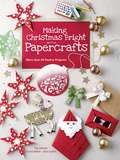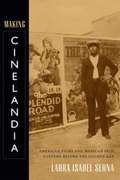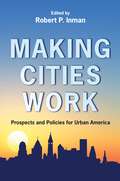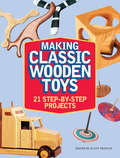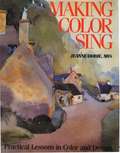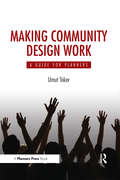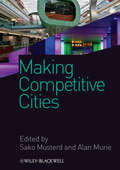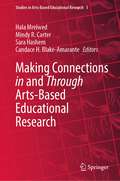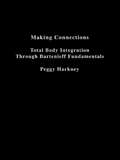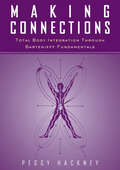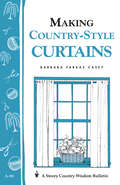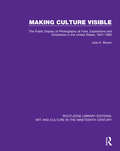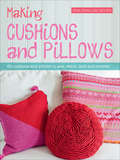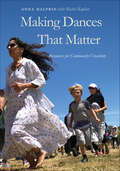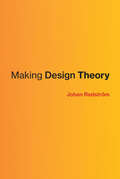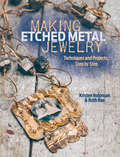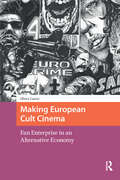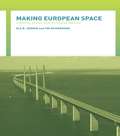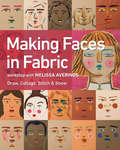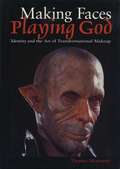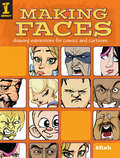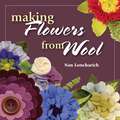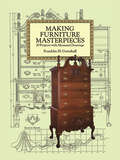- Table View
- List View
Making Caribbean Dance: Continuity and Creativity in Island Cultures
by Susanna SloatExplore the vibrant and varied dance traditions of the Caribbean islandsCaribbean dance is a broad category that can include everything from nightclubs to sacred ritual. Making Caribbean Dance connects the dance of the islands with their rich multicultural histories and complex identities. Delving deep into the many forms of ritual, social, carnival, staged, experimental, and performance dance, the book explores some of the most mysterious and beloved, as well as rare and little-known, dance traditions of the region.From the evolution of Indian dance in Trinidad to the barely known rituals of los misterios in the Dominican Republic, this volume looks closely at the vibrant and varied movement vocabulary of the islands. With distinctive and highly illuminating chapters on such topics as experimental dance makers in Puerto Rico, the government's use of dance in shaping national identity in Barbados, the role of calypso and soca in linking Anglophone islands, and the invented dances of dance-hall kings and queens of Jamaica, this volume is an evocative and enlightening exploration of some of the world’s most dynamic dance cultures.
Making Christmas Bright with Papercrafts: More Than 40 Festive Projects!
by Alice Hornecke Dominik Meißner Sabine SeyffertChristmas is an ideal time to get in the spirit of the season by creating festive decorations and gifts with a personal touch. This delightful collection of 43 unique papercraft projects will get everyone in a festive mood with its decorative suggestions for the home and the holiday table, Christmas tree ornaments, handmade gifts, and much more. The book abounds in photos, templates, and easy-to-follow instructions for everything from a beautiful origami wreath to cut-out snowflakes, place-setting accessories, gift-wrapping accents, and an Advent candle holder. Each project is accompanied by helpful tips as well as a list of materials and measurements. The splendid variety of options make this the perfect guide and resource for papercrafters at every level of experience.
Making Cinelandia: American Films and Mexican Film Culture before the Golden Age
by Laura Isabel SernaIn the 1920s, as American films came to dominate Mexico's cinemas, many of its cultural and political elites feared that this "Yanqui invasion" would turn Mexico into a cultural vassal of the United States. In Making Cinelandia, Laura Isabel Serna contends that Hollywood films were not simply tools of cultural imperialism. Instead, they offered Mexicans on both sides of the border an imaginative and crucial means of participating in global modernity, even as these films and their producers and distributors frequently displayed anti-Mexican bias. Before the Golden Age of Mexican cinema, Mexican audiences used their encounters with American films to construct a national film culture. Drawing on extensive archival research, Serna explores the popular experience of cinemagoing from the perspective of exhibitors, cinema workers, journalists, censors, and fans, showing how Mexican audiences actively engaged with American films to identify more deeply with Mexico.
Making Cities Work: Prospects and Policies for Urban America
by Robert P. InmanMaking Cities Work brings together leading writers and scholars on urban America to offer critical perspectives on how to sustain prosperous, livable cities in today's fast-evolving economy. Successful cities provide jobs, quality schools, safe and clean neighborhoods, effective transportation, and welcoming spaces for all residents. But cities must be managed well if they are to remain attractive places to work, relax, and raise a family; otherwise residents, firms, and workers will leave and the social and economic advantages of city living will be lost. Drawing on cutting-edge research in the social sciences, the contributors explore optimal ways to manage the modern city and propose solutions to today's most pressing urban problems. Topics include the urban economy, transportation, housing and open space, immigration, race, the impacts of poverty on children, education, crime, and financing and managing services. The contributors show how to make cities work for diverse urban constituencies, and why we still need cities despite the many challenges they pose. Making Cities Work brings the latest findings in urban economics to policymakers, researchers, and students, as well as anyone interested in urban affairs. In addition to the editor, the contributors are David Card, Philip J. Cook, Janet Currie, Edward L. Glaeser, Joseph Gyourko, Richard J. Murnane, Witold Rybczynski, Kenneth A. Small, and Jacob L. Vigdor.
Making Classic Wooden Toys: 21 Step-by-Step Projects
by Scott FrancisMake toys that will be treasured for generations! Wooden toys stand the test of time. They're played with, love and often go on to become treasured family heirlooms. Plus making toys is a great way to put to good use all those small offcuts of nicer wood you've been saving.Making Classic Wooden Toys is filled with 21 projects selected from the archives of Popular Woodworking Magazine and American Woodworker. The toys inside hark back to a time of childhood wonder and fun. From tricky puzzles and clever gizmos to sports equipment and kid's furniture, you'll learn to make a wide array of gifts that any child is sure to love. Within these pages you'll find step-by-step instructions along with helpful photos and illustrations for:A variety of wooden puzzlesTabletop versions of games including hockey and foosballFun furniture including a play table, a game table and a tractor-trailer toyboxPopular lawn games including bocce and kubbSpinning tops, whistles and other classic toysWhat better way to show your love for a child than with a handmade wooden toy that will be passed on for generations to come?
Making Color Sing
by Jeanne Dobie<P>In this innovative book, author and crafter Carolyn Dahl demonstrates how printing with a natural material--covering it with a medium and pressing it to a surface--allows artists to see and appreciate exquisite, often-overlooked details and make physical contact with the earth that sustains us. Natural Impressions begins with practical guidance on collecting materials and objects, along with basic instructions for making a successful nature print. <P> Divided into three sections--leaves, flowers, and fish--the book clearly demonstrates a variety of techniques using an array of mediums; for example, paints/pigments, bleach, collage, markers, textile paints, and even rubber stamps. Plus, a special section details how nature prints can meet today's technology with photocopying and computer manipulation.
Making Community Design Work: A Guide For Planners
by Umut TokerSince the earliest settlements, people have deliberated the issues that affect their future together. Making Community Design Work shows how planners can guide the process toward effective decision making and beneficial community design. This well-crafted book distills decades of community design experience into a sound conceptual framework of value to practicing planners as well as planning students. Umut Toker covers a broad range of planning scales and introduces field-tested tools for participatory decision making at regional, city, community, and site-specific levels. To succeed, any planning project must address both the physical space and its users. From setting goals to evaluating results, Making Community Design Work helps planners navigate the process of creating environments that meet the needs of the people they serve.
Making Competitive Cities
by Sako Musterd Alan MurieThe book investigates the impact on the competitiveness of cities developing creative industries (arts, media, entertainment, creative business services, architects, publishers, designers) and knowledge-intensive industries (ICT, R&D, finance, law). It provides significant new knowledge to the theoretical and practical understanding of the conditions necessary to stimulate "creative knowledge" cities.The editors compare the socio-economic developments, experiences and strategies in 13 urban regions across Europe: Amsterdam, Barcelona, Birmingham, Budapest, Dublin, Helsinki, Leipzig, Milan, Munich, Poznan, Riga, Sofia and Toulouse. These have different histories and roles; include capital and non-capital cities of different sizes; represent cities with different economic structures; and different cultural, political and welfare state traditions.Through this wide set of examples, Making Competitive Cities informs the debate about creative and knowledge-intensive industries, economic development, and competitiveness policies. It focuses on which metropolitan regions have a better chance to develop as "creative knowledge regions" and which do not, as well as investigating why this is so and what can policy do to influence change.Chapter authors from thirteen European institutions rigorously evaluate, reformulate and empirically test assumptions about cities and their potential for attracting creative and knowledge-intensive industries. As well as a systematic empirical comparison of developments related to these industries, the book examines the pathways that cities have followed and surveys both the negative and positive impacts of different prevailing conditions.Special Features:Analyses link between knowledge-intensive sectors and urban competitivenessOffers evidence from 13 European urban regions drawn from a major research projectEstablishes a new benchmark for academic and policy debates in a fast-moving field
Making Connections in and Through Arts-Based Educational Research (Studies in Arts-Based Educational Research #5)
by Mindy R. Carter Hala Mreiwed Sara Hashem Candace H. Blake-AmaranteThis book explores the connections made in and through arts-based educational research through four themes: socially engaged connections, cultural connections, personal and pedagogical connections, and making connections during the COVID-19 pandemic. It emerges from the 3rd bi-annual 2020 Artful Inquiry Research Group symposium on the theme of “connections”. The symposium brought together artists, community members, teachers, students, and researchers through a virtual platform to examine the way(s) in which the arts can help connect people, ideas, and spaces/places in a pandemic reality. Art plays a predominant role in each chapter as authors weave their research and art-based understandings together. This book is a valuable teaching resource for undergraduate and postgraduate courses in teaching, anthropology, digital ethnography, autoethnography, cultural studies, and communications. It is of interest to higher education students, academic researchers, and teachers exploring arts-based methodologies in the fields of creative practice and creativity studies, communications, critical studies, sociology, sciences, teacher education, and the arts.
Making Connections: A Free-Motion Quilting Workbook
by Dorie HruskaQuilt with fewer starts and stops! Streamline your free-motion quilting with this workbook full of exercises to build your skills. Easy-to-follow, step-by-step illustrations for each design suite show how to adapt the quilting design for blocks, borders, sashing, and allover quilting. Practice each design with a pencil on the included practice pages before stitching by machine, then put your skills to the test on a gorgeous pieced sampler project. These creative continuous-line quilting designs can be used on both longarm and domestic machines. • Learn from an award-winning longarm machine quilter • Combine 12 free-motion motifs for limitless possibilities, including curves, curls, leaves, spikes, waves, and loops • Fill in four-grid blocks, triangles, borders, and more with these deceptively simple designs
Making Connections: Total Body Integration Through Bartenieff Fundamentals
by Peggy HackneyHuman movement influences an individual's perceptions and ability to interact with the world. Through exercises, illustrations, and detailed anatomical drawings, this remarkable book guides the reader toward total body integration. An experimental approach to movement fundamentals involving the patterning of connections in the body according to principles of efficient movement, the process of total body integration encourages personal expression and full psychological involvement.
Making Connections: Total Body Integration Through Bartenieff Fundamentals
by Peggy HackneyThis book explores how we go about creating the connections within us that allow us to become fully embodied human beings in the world. It provides some very personal memories of Irmgard Bartenieff and the development of her approach to Fundamentals.
Making Country-Style Curtains: Storey's Country Wisdom Bulletin A-98 (Storey Country Wisdom Bulletin Ser.)
by Barbara Farkas CaseySince 1973, Storey's Country Wisdom Bulletins have offered practical, hands-on instructions designed to help readers master dozens of country living skills quickly and easily. There are now more than 170 titles in this series, and their remarkable popularity reflects the common desire of country and city dwellers alike to cultivate personal independence in everyday life.
Making Culture Visible: The Public Display of Photography at Fairs, Expositions and Exhibitions in the United States, 1847-1900 (Routledge Library Editions: Art and Culture in the Nineteenth Century #3)
by Julie K. BrownFirst published in 2001. Making Culture Visible provides a fresh focus on the history of nineteenth-century photography. The narrative moves from a close focus on several selected events between 1847 and 1900, beginning with six industrial fairs of the 1840s-1860s to the looming presence of the Philadelphia Centennial Exhibition in the mid-1870s. The last two chapters deal with the exhibition work of the Smithsonian Institution’s US National Museum in the 1880s and finally the collecting and displays of public libraries in the 1890s. The evolution of the increasingly complex social function of photography is clearly demonstrated.
Making Cushions and Pillows: 60 Cushions and Pillows to Sew, Stitch, Knit and Crochet
by Nina Granlund SaetherA fabulous collection of 60 contemporary cushion designs to transform your home. Using a range of different techniques from crochet to knitted intarsia motifs, cross stitch and embroidery, you can create cushions to suit any living space. Features endless gorgeous designs and ideas for all abilities. Includes a fully illustrated techniques section.
Making Dances That Matter: Resources for Community Creativity
by Rachel Kaplan Anna HalprinAnna Halprin, vanguard postmodern dancer turned community artist and healer, has created ground-breaking dances with communities all over the world. Here, she presents her philosophy and experience, as well as step-by-step processes for bringing people together to create dances that foster individual and group well-being. At the heart of this book are accounts of two dances: the Planetary Dance, which continues to be performed throughout the world, and Circle the Earth. The Circle the Earth workshop for people living with AIDS has generated dozens of "scores" for others to adapt. In addition, the book provides a concrete guide to Halprin's celebrated Planetary Dance. Now more than 35 years old, Planetary Dance promotes peace among people and peace with the Earth. Open to everyone, it has been performed in more than 50 countries. In 1995 more than 400 participants joined her in a Planetary Dance in Berlin commemorating the fiftieth anniversary of the signing of the Potsdam Agreements, at the end of World War II. More recently, she took the Planetary Dance to Israel, bringing together Israelis and Palestinians as well as other nationalities. Throughout this book Halprin shows how dance can be a powerful tool for healing, learning and mobilizing change, and she offers insight and advice on facilitating groups. If we are to survive, Halprin argues, we must learn, experientially, how our individual stories weave together and strengthen the fabric of our collective body. Generously illustrated with photographs, charts and scores, this book will be a boon to dance therapists, educators and community artists of all types.
Making Design Theory (Design Thinking, Design Theory)
by Johan RedstromA new approach to theory development for practice-driven research, proposing that theory is something made in and through design.Tendencies toward “academization” of traditionally practice-based fields have forced design to articulate itself as an academic discipline, in theoretical terms. In this book, Johan Redström offers a new approach to theory development in design research–one that is driven by practice, experimentation, and making. Redström does not theorize from the outside, but explores the idea that, just as design research engages in the making of many different kinds of things, theory might well be one of those things it is making.Redström proposes that we consider theory not as stable and constant but as something unfolding—something acted as much as articulated, inherently fluid and transitional. Redström describes three ways in which theory, in particular formulating basic definitions, is made through design: the use of combinations of fluid terms to articulate issues; the definition of more complex concepts through practice; and combining sets of definitions made through design into “programs.” These are the building blocks for creating conceptual structures to support design. Design seems to thrive on the complexities arising from dichotomies: form and function, freedom and method, art and science. With his idea of transitional theory, Redström departs from the traditional academic imperative to pick a side—theory or practice, art or science. Doing so, he opens up something like a design space for theory development within design research.
Making Etched Metal Jewelry: Techniques and Projects, Step by Step
by Ruth Rae Kristen RobinsonCopper, brass, and silver! Looking to take your jewelry skills and experience to the next level? With Making Etched Metal Jewelry you will become an alchemist, a magician, a historian, a storyteller.... The rewards of making etched metal jewelry are plenty. There really is no other way to create jewelry that holds such depth, texture, romance and history. The images you etch are all up to you--use stamps, photos, hand drawn symbols or handwritten text. Add velvet, gemstones, pearls and other bits of ephemera meaningful to you and create something that is truly one of a kind! With Making Etched Metal Jewelry you will: Learn several techniques for etching brass, copper and nickel silver of all shapes and sizes, following step by step instruction and extensive safety precautions. Make 17 step-by-step projects including necklaces, bracelets, earrings, rings and more. Incorporate beads, wirework, fabric, ribbon, photos, soldering and more into your jewelry as you master techniques as varied as wrapping bead dangles and cutting and doming metal circles. Make a statement. Make an heirloom. Make etched metal jewelry!
Making European Cult Cinema: Fan Enterprise in an Alternative Economy (Transmedia)
by Oliver CarterFans of cult films don't just watch the movies they love-they frequently engage with them in other, more creative ways as well. Making European Cult Cinema explores the ways in which that fandom could be understood as an alternative economy of fan enterprise, through a close look at how fans produce and distribute artifacts and commodities related to cult films. Built around interviews and ethnographic observations-and even the author's own fan enterprise-the book creates an innovative theoretical framework that draws in ideas from cultural studies and political economy to introduce the concept of an 'alternative economy' as a way to understand fan productions.
Making European Space: Mobility, Power and Territorial Identity
by Tim Richardson Ole B. JensenMaking European Space explores how future visions of Europe's physical space are being decisively shaped by transnational politics and power struggles, which are being played out in new multi-level arenas of governance across the European Union. At stake are big ideas about mobility and friction, about relations between core and peripheral regions, and about the future Europe's cities and countryside. The book builds a critical narrative of the emergence of a new discourse of Europe as 'monotopia', revealing a very real project to shape European space in line with visions of high speed, frictionless mobility, the transgression of borders, and the creation of city networks. The narrative explores in depth how the particular ideas of mobility and space which underpin this discourse are being constructed in policy making, and reflects on the legitimacy of these policy processes. In particular, it shows how spatial ideas are becoming embedded in the everyday practices of the social and political organisation of space, in ways that make a frictionless Europe seem natural, and part of a common European territorial identity.
Making Faces in Fabric: Workshop with Melissa Averinos
by Melissa AverinosLearn appliqué techniques to create a face and add it to any textile craft project.Discover how to create freeform, raw-edge appliqué faces using Melissa Averinos’s fun, creative process. Melissa walks you through the process step by step, from a comprehensive lesson on drawing the face, to translating your sketch into fabric, to stabilizing the piece with stitching, to incorporating your stylized face into a finished project, whether it’s a pillow, tote, shirt, or stretched canvas! Learn how to make a variety of eyes, noses, lips, hair, and face shapes, as well as how to create facial features in just the right proportions. You’ll be amazed by how good the final portrait looks! • Personalize your fabric collage! Learn several different ways of creating facial features• Comprehensive lessons on fabric choices, color, and shading• Includes inspirational galleries of work from Melissa and her students
Making Faces, Playing God: Identity and the Art of Transformational Makeup
by Thomas MorawetzWearing a mask-putting on another face-embodies a fundamental human fantasy of inhabiting other bodies and experiencing other lives. In this extensively illustrated book, Thomas Morawetz explores how the creation of transformational makeup for theatre, movies, and television fulfills this fantasy of self-transformation and satisfies the human desire to become "the other. " Morawetz begins by discussing the cultural role of fantasies of transformation and what these fantasies reveal about questions of personal identity. He next turns to professional makeup artists and describes their background, training, careers, and especially the techniques they use to create their art. Then, with numerous before-during-and-after photos of transformational makeups from popular and little-known shows and movies, ads, and artist's demos and portfolios, he reveals the art and imagination that go into six kinds of mask-making-representing demons, depicting aliens, inventing disguises, transforming actors into different (older, heavier, disfigured) versions of themselves, and creating historical or mythological characters.
Making Faces: Drawing Expressions For Comics And Cartoons
by 8fishChances are, you already know how to draw some expressions. But face it, your stories can only get so far with "happy," "sad" and "angry." In order to give your characters some character, you need to know what they look like when they're about to sneeze, when they smell something stinky or when they're flirting, horrified or completely blotto. Lucky for you, that's what this book is all about! Making Faces contains everything you need to give your characters a wide range of expressions! Part 1: The Basics. How to draw heads, mouths, noses and eyes, and how they change shape when they move.Part 2: The Faces. Over 50 step-by-step demonstrations for a variety of expressions divided into scenarios. Each scenario shows four or five expressions from a single character, from simple emotions to more subtle and complex variations, so you see how a face changes with each emotion. Sidebars illustrate the same expressions on a variety of other characters.Part 3: Storytelling.How to move your story along using expression, point of view, body language and composition. See how it all comes together with damsels in distress, a noir-style interrogation, a Western standoff and other situations. Illustrated with a diverse cast of characters from hobos to superheroes to teenage girls, this guide will help you create the looks that say it all.
Making Flowers from Wool
by Nan LoncharichUse simple techniques--hand stitching, cutting, and gluing--to create hundreds of different flowers for pins, hatbands, party favors, gifts, decorations, and more.
Making Furniture Masterpieces: 30 Projects with Measured Drawings
by Franklin H. GottshallThis clearly written how-to book by master craftsman Franklin H. Gottshall allows woodworkers to construct handsome, useful furniture in the most highly regarded antique styles. Characterized by beauty and richness of design, each of 30 different projects -- all replicas of actual rare furniture -- can be completed by ambitious beginners as well as skilled crafters for only a fraction of what vintage originals would cost.Woodcrafters can choose from pieces spanning a wide variety of styles -- from a simple dovetailed box to an elegant Philadelphia Chippendale highboy. Included as well are directions for constructing a Dutch cupboard, refectory table, gateleg table, shelf top corner cupboard, Queen Anne hall table, Pennsylvania Dutch painted chest, and other distinctive pieces.Easy-to-follow, step-by-step instructions are accompanied by photographs and drawings as well as front and end views and detailed sketches of parts and procedures. Decorative skills such as woodcarving, upholstering, finishing, and wrought-iron work are also fully described and related for each piece.

